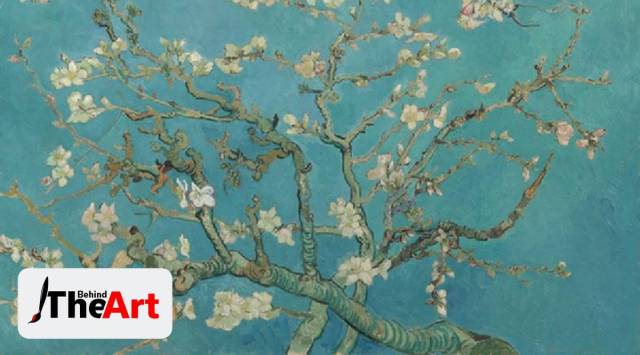Behind the Art: What is the significance of Almond Blossom (1890) by Vincent van Gogh?
Behind the Art: Almond Blossom made in 1890 was made to celebrate the birth of Van Gogh's nephew and namesake, the son of his brother Theo and sister-in-law Jo. But why is the 1890 version of Almond Blosson so significant? Is it really priceless?
 The tree's distinctive contours and position in the foreground allude to the formal characteristics of Japanese prints in the Almond Blossom. (Pic source: Van Gogh Museum website)
The tree's distinctive contours and position in the foreground allude to the formal characteristics of Japanese prints in the Almond Blossom. (Pic source: Van Gogh Museum website)In 1890, Dutch genius Vincent van Gogh painted Almond Blossom – a painting so impressive that art lovers flock to see it at the Van Gogh Museum every day. Priceless because it was never to be sold, it is a part of several paintings made in 1888 and 1890 by Vincent van Gogh in Arles and Saint-Rémy, southern France of blossoming almond trees. Flowering trees were special to Van Gogh as they represented awakening and hope. He found pleasure in painting flowering trees and enjoyed their aesthetic appeal. The works are influenced by Japanese woodcuts, divisionism, and Impressionism. Almond Blossom made in 1890 was made to celebrate the birth of his nephew and namesake, the son of his brother Theo and sister-in-law Jo. But why is the 1890 version of Almond Blosson so significant? Is it really priceless?
A ray of hope was born and a masterpiece was created
Almond Blosson was given as a present to his brother Theo and sister-in-law Jo, who had recently given birth to a son named Vincent Willem van Gogh. Theo wrote to his brother Vincent on January 31, 1890, to announce the birth of his son saying “We’ll name him after you, as we promised, and I’m hoping he will be as determined and brave as you.” Van Gogh started working on a painting for Theo and his wife as a way to celebrate. He wanted Vincent’s birth to be symbolised by the almond tree’s blossoms, as he was very close to his brother. Early in the springtime, almond trees tend to bloom and as a result, the tree signifies the beginning of spring and new life. It should not come as a surprise that the Van Gogh family held this piece of art the dearest. Vincent Willem established the Van Gogh Museum and Almond Blossom was so priceless to Jo and her son that the Van Gogh Museum still has it on display.
Why is Almond Blosson considered a masterpiece?
Van Gogh was able to free himself from the strict self-analytical approach he took in Paris and reached a sense of spontaneity in his flowering trees. He created a sparkling surface effect in Almond Tree in Blossom by employing divisionism’s dabs of colour and impressionism’s light, broken strokes. The tree’s distinctive contours and position in the foreground allude to the formal characteristics of Japanese prints. Almond Blossom’s rendering is close to the viewer and easily visible, and the branches appear to extend beyond the painting’s frame. Van Gogh’s composition is unique among his works. The close-up of the almond tree’s branches brings to mind Delacroix’s assertion that “even a part of a thing is kind of a complete entity in itself.” The branches appear to float against the blue sky and fill the picture plane. The branches are outlined by dark lines. This is a characteristic that Van Gogh admired in Japanese floral studies, which, for instance, may depict a portion of a bamboo stalk in a space. The bright colour is indicative of the paintings that Van Gogh created in Arles and the transforming influence that he had on the still life genre.
Why did Van Gogh paint Almond Blossoms?
To put it simply, Van Gogh painted one of his favourite subjects – nature. He loved nature and blossoming trees, like in the painting Almond Blossom, was one of his favourite subjects to paint. He painted several variations on the theme: ranging from a small flowering sprig in a glass to lavishly blossoming trees. The painting Almond Blossom represented a fresh start for Van Gogh. He had been in an asylum in Saint-Rémy for almost ten months at the time. Van Gogh had been ill and had had an attack, so he hadn’t worked in weeks. He was now permitted to return outdoors to paint amid nature. The blossoming trees were viewed from a unique perspective by the artist. He painted the branches very close up and from below. You feel as though you are lying on your back on the grass and looking up at the branches above you, obscuring the tree as a whole. Vincent was inspired by this method used in Japanese printmaking.
Hope, Art and Suicide
In a tragic turn of events, Van Gogh suffered a second mental breakdown shortly after painting Almond Blossom, which prevented him from painting additional almond flowers and put him in long-term recovery. Vincent put in a lot of effort, but it cost him a lot. A new disappointment awaited him once he had recovered: Vincent had missed his favourite time of year for flowers. He wrote to Theo about this on April 29, 1890, writing: “You can deduce from that that I would have completed other blossoming trees if I had been able to continue working. Now that the blossoming trees are nearly finished, I really have no luck.” In the same letter, Van Gogh told his brother that he wanted to leave the asylum because he was “sad and bored” and didn’t know what to do. He soon moved to the village of Auvers-Sur-Oise, which is near Paris. He was able to be closer to his brother Theo and his doctor, Dr Paul Gachet. Van Gogh shot himself in the chest on July 27, 1890, almost two months after the aforementioned letter. The world lost a talented artist that day who broke the barriers of traditional art with his thick brushstrokes and a different perspective. The painting which hung over his nephew’s bed and gave him hope now hangs publicly as a symbol of happiness for many – and happiness certainly is priceless.
(Next up in Behind the Art: What is the story behind Pablo Picasso’s Le Rêve which is worth $155 million?)
📣 For more lifestyle news, follow us on Instagram | Twitter | Facebook and don’t miss out on the latest updates!







- 01
- 02
- 03
- 04
- 05





















